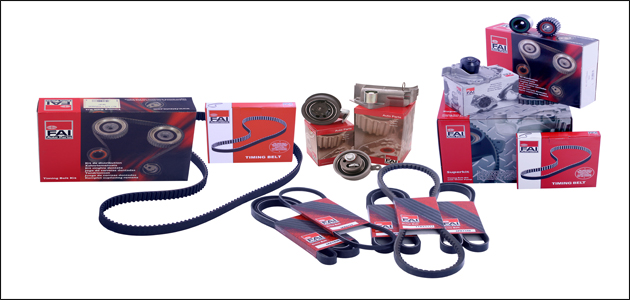
Millions of cars on the road today have an automatic Poly V belt tensioner on the engine, designed to keep the belt tight on the pulleys. These tensioners play a vital role in the smooth performance and reliability of the vehicle, so regular inspection is vital, particularly if you are fitting a new belt.

FAI’s vast timing belt and chain kits range
What to do
Check the belt’s condition and replace if necessary. If the tensioner feels too tight, make sure that the correct belt is installed and that all accessory pulleys are the correct size. Often, the tensioner will have a built-in wear indicator – usually a line in the casting.
If the tensioner indicator points toward the belt being loose, the belt may be worn or stretched and must be replaced. Alternatively, if the indicator points towards the belt being too tight, the incorrect belt may be installed or an accessory may have an incorrectly-sized pulley.
If the tensioner feels seized, is sticking or broken, or the pulley feels rough when you spin it, we advise that you replace the tensioner right away.
Damping
One job of the Poly V belt tensioner is to keep tension on the belt so it won’t slip. But the other job is to compensate for, or combat, engine vibrations, or damping engine vibrations. Types of damping include:
Friction Damping
- Can be external (visible) or internal (hidden within the part).
- Incorporates some type of nylon element hat helps grip the internal components of the tensioner.
Hydraulic damping
- Easy to spot because there will typically be a small hydraulic shock absorber attached to the outside of the tensioner.
What to look for
The damping part of the tensioner can wear out over time. Here are a few tips to assist with spotting a potentially worn-out damping system:
a) Take note of how the tensioner damping feels when you cycle a tensioner to remove the belt. If it cycles very easily, then the damping element may be worn out.
b) If the tensioner moves back and forth quickly, then the tensioner may require replacement.
c) The centre of the tensioner ’s pulley should never move more than ¼˝.
Timing experts
FAI supplies timing belts, tensioners and pulleys either as separate parts or as highly specified kits, including Superkits that contain the correct water pump reference for the vehicle. It is often time saving and more reliable to replace the water pump at the same time as the belt.
Timing chain kits are another FAI competence, with kits for many of the most modern vehicles on the road. Additionally, the company distributes the Goodyear Engineered Products Belting Range – which has a unique ‘Fit & Relax’ warranty guarantee for both parts and labour across the UK and Eire.
INSPECTION PROCEDURES FOR AUTOMATIC BELT TENSIONERS
LOOK
Engine running at idle:
- Look for excessive tensioner movement
- Look for pulley wobble
- Look for belt misalignment on the pulley
Engine shut off:
- Look at the pulley, is the belt running near the center?
- Does the tensioner appear to be tilted off to one side?
- Look for excessive corrosion on the pulley.
- Look for red rust coloured dust coming out of the front of the tensioner.
- Look for damaged bearing seal or grease leaking out of the pulley bearing.
FEEL
With the engine shut off and the Poly V belt removed:
- Use the correct tool to rotate the tensioner throughout its entire range. If the tensioner feels seized or is ‘notchy’, then it may be time to replace it.
- Feel the pulley with a gentle up and down rocking motion. If excessive play is noted, the pulley may need to be replaced.
LISTEN
With the engine running:
- Listen for any abnormal noises (belt squeaks/buzz or whining noises) coming from the belt drive.
With the engine stopped:
- Remove the belt and spin the tensioner pulley by hand; listen carefully for any noises. Inspect and rotate all the pulleys in the belt drive system. Idlers, water pump, power steering, air conditioning and alternator should all spin freely without noise.
With the engine shut off and the Poly V belt removed:
- Use the correct tool to rotate the tensioner throughout its entire range. If the tensioner does not feel and sound ‘smooth’ then it may be time to replace it.









